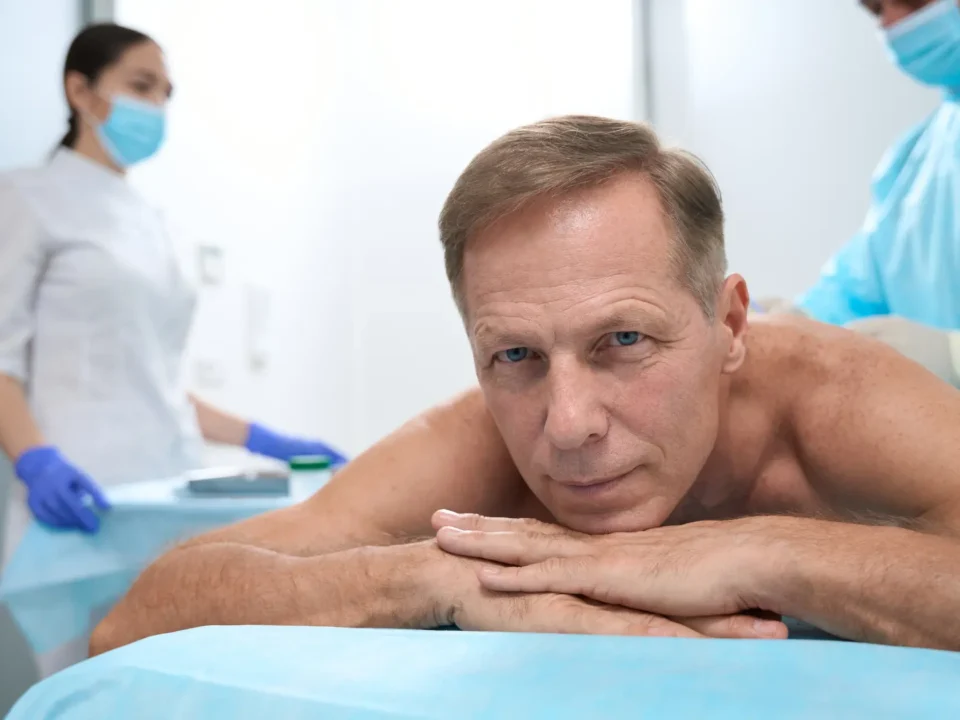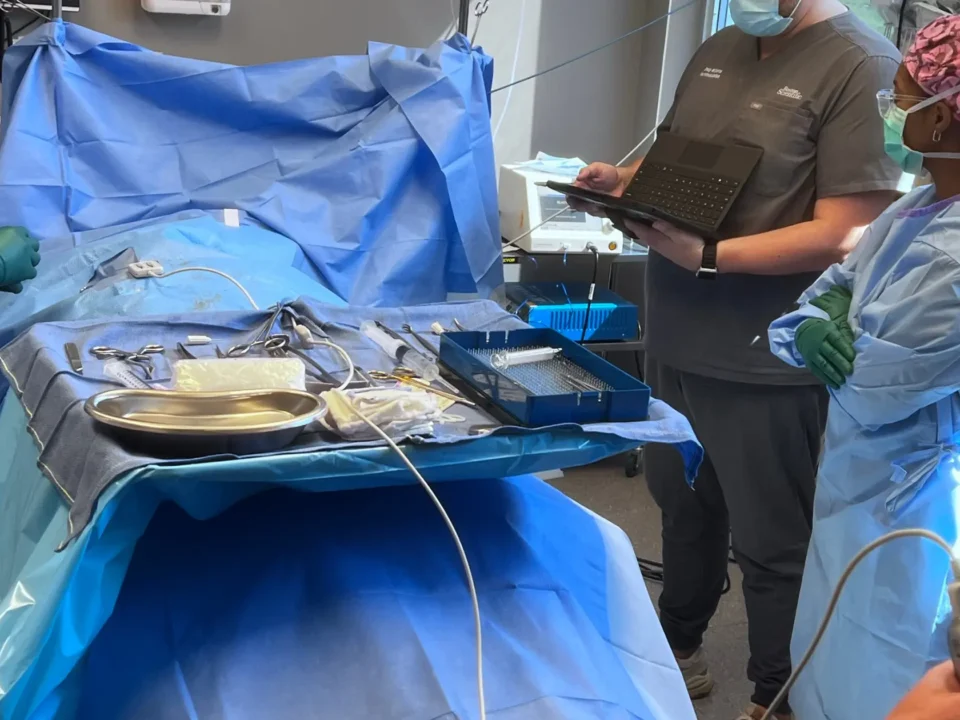Marshall Morris: Hello, hello. This is the super tall Marshall Morris and today I am joined by Dr. Patel. Dr. Patel, welcome back to the podcast. How are you doing?
Dr. Patel: Thank You Marshall. Good to be here.
Marshall: Good to hear and we we’re talking a lot about Oklahoma pain and wellness but to really understand the clinic here, we really want to make sure that you can understand maybe the faces behind the practice, okay? And the different providers within Oklahoma pain and wellness and so we’re going take the episode here today and we’re actually going to explain this for all of the listeners out there. Dr. Patel, maybe the best provider to start with is yourself. Why don’t you walk us through maybe your bio here and maybe give you an opportunity to shamelessly plug yourself, okay?
Dr. Patel: Thanks Marshall. Well, it’s always difficult to talk about yourself but when it helps patients I think it makes it a bit easier sure. I grew up in Kenya, in Nairobi which is in East Africa. It’s a big cosmopolitan city. I went to a school based on a medium of the Cambridge University program in England and I was there until I was 17. I basically went to one school most of my life in high school and it was a small classroom size. It had a strong emphasis on mathematics and science and that’s what initially tweak my interest in medicine.
My story is a little unique because I grew up with my childhood best friend and I saw him nearly every day of my life all through medical school as well and we moved from Kenya to undergrad together. Him and I became biology majors and we completed our undergrad at Boston University in biology. I was the class speaker at the end of that year and I graduated with honors and summa cum laude. At that time, both my friend and I went to Boston University together. We completed four years of MD Education at Boston Medical Center and the affiliated hospitals. I took an extra year to try and find what specialty fit my personality the best and in so doing, I spent a lot of international work particularly in Kenya doing tropical ophthalmology and working with different physicians doing infectious disease in Peru which helped me develop a little more of an expertise in Spanish and medical Spanish as well.
After that, I moved to Mount Sinai Hospital in New York City to do my internship in general surgery. I decided to do general surgery because it was very procedural oriented. I knew that in my eventual life I would be doing a lot of surgery as well as interventions and so it would have served me better than doing something basically in medicine. After that, I completed a three-year program in anesthesiology at NYU Hospital and particularly in the last few months, I specifically specialized in Tulsa pain management.
After that I worked for about a year in the Bronx in New York City and subsequently moved to Tulsa where I’ve been ever since for the last approximately eight years. I started with a group practice and then started my own practice as an individual. I grew to two providers within a year and after that about three years ago in 2012, I moved into a larger facility where we opened our own Tulsa pain management practice and one of the only spa ambulatory surgery centers dedicated to Tulsa pain management in Oklahoma, which is on site. We also opened up our own toxicology lab to help curb the epidemic of prescription drug abuse in Oklahoma which really we stand out and as in as a state and I wasn’t proud of that and I certainly wanted to make sure we’re not part of the problem and having an in-house lab helped us get results very quickly and efficiently and we’ve been very proud of that. We’ve also been able to develop a stellar anesthesiology program on site and now we are approximately nine providers at the center.
Marshall: That’s amazing that you’ve taken it upon yourself to not become part of the problem of prescription drug abuse and you said the toxicology lab right there on site at Oklahoma pain and wellness helps you curb that and mitigate that problem.
Dr. Patel: Yes, and it’s not as simple as it sounds. We’ve taken it to another step. Oklahoma Pain and Wellness has committed half-a-million dollars this year to hire three other physicians for drug recovery programs. We don’t think that just because someone tested positive for using an illicit substance such as heroin or cocaine or PCP, that they should be kicked to the curb and be someone else’s problem. We don’t have many mental health specialists in Oklahoma or in the southwest region as a whole.
Drug rehabilitation programs are fraught with expense and problems as well and they just are not that many in this part of the world. There’s also a sense in our community that we should turn our backs to people who may have a drug addiction and that sort of addiction has played every socio-economic status in our community as Americans. It affects young, old, men, women, black, white, poor, rich, educated, uneducated, it affects all of us as Americans.
With this investment of bringing three physicians in, we bring in a program where we can counsel and be available to individuals with drug addiction right away and immediately as a group practice, or as an individual practice. But on top of that, use medications to help them recover from these issues and each of those physicians has an addictionology fellowship.
Marshall: That’s one of those things that makes Oklahoma Pain and Wellness really stand out from maybe other clinics or other practices from what I understand here in Tulsa and the region. But let me ask you this before we get to learn a little bit more about the other providers that you have on staff, what really captured your attention or captured your interest about Tulsa pain management and anesthesiology? What was your kind of specific interest when it came to that?
Dr. Patel: I think it was a balance between making very brief and positive encounters with patients coupled with the fact that you can actually have long-term impact on patients and develop long-term relationships. Unfortunately anesthesiologist work very hard to take care of a patient and may never see them again. But with Tulsa pain management, you get the best of both worlds. You get to do that but you also get to see their long-term progress and on top of that, you get the added benefit of not only seeing the patient benefit over time, but you get to do interventions as well as office-based. They’re very few specialties in medicine which give you that breath. But on top of that as well, as a added bonus, you just get to see some of the most fantastic recovery processes for patients and the appreciation you get, it really takes individuals with a very difficult position in their life and you’re able to make a positive change.
Marshall: You’re dealing with not just a discomfort, you’re not just dealing with a six-week problem or a rehab process, you’re dealing with pain which some of these patients have lived with for years and to be part of that recovery processes is, I imagine, very fulfilling.
Dr. Patel: It is and to give people hope particularly families who have had to take care of individuals in their households to give them some hope of improvement, to give them some sort of foundation, some sort of help, is an incredible feeling for all our providers as well as our staff. It doesn’t just take that providers, it takes entire staff at Oklahoma Pain and Wellness to relate to these physicians and relate to individuals who are coming to us at their worst time.
Marshall: Yes. I imagine it’s not just a patient, it’s the family surrounding the patient, the friends supporting the patient, that have had to help or have volunteered their assistance in helping manage that and you’re providing a relief not just for the patient but for the entire group of people surrounding them.
Dr. Patel: That’s right. I think that focus is paramount with all our providers and staff. A lot of staff can work in any sort of industry they want to. We have extremely bright young professional dynamic individuals who work at Oklahoma Pain and Wellness but that doesn’t mean that they can’t get a job anywhere else. They can do anything they want to but they choose to do this and they choose to do this because they see the positive impact it makes in individuals’ lives.
Marshall: Let’s go ahead and meet some of these people. The first person I want you to introduce is Dr. Leslie Chan. Tell me a little bit about Dr. Chan. Dr. Chan comes to us most recently from Missouri and the most interesting part of it with Dr. Chan is that he grew up in Singapore and went to medical school there in one of the best medical schools in the world in an environment that is extremely competitive. Out of the gates, it tells you what an incredible physician this is. He also trained in one of the top five institutions of medicine in America, in the University of San Francisco. Over there, he also did his fellowship in Tulsa pain management. He does a whole armamentarium of procedures and his expertise is in implantable devices. He does spinal injections, he does medical management, but on top of that he has an expertise particularly in implantable devices with a spinal cord stimulators or implantable intrathecal pumps or fracture repair as well. He comes with more than around a decade of experience doing all these procedures.
Marshall: I’m just looking and for anybody listening, they can go onto the website and learn more about the all of the different proficiencies that he has. But he’s an expert in all of these different treatments and procedures, but let me ask you, when you say implantable devices, break that down to like a third-grade level for me. For somebody that’s experiencing pain, how and when would they have one of these implantable device procedures done?
Dr. Patel: Although there are many applications, the most important application occurs after back surgery. If an individual’s had a back surgery for some sort of instability, be it from a traumatic issue or a long-standing instability from a disc herniation, then they may undergo a fusion surgery. After that, sort of instrumentation patients may be left with intractable back pain, intractable sciatica and searing pain down the leg. That may not recover from interventions like injection therapy, oral pain medications, membrane stabilizing medications and multiple other interventions.
Those individuals at that point have failed what we call conservative therapy beyond the surgery and they have aberrant messages of pain going down their back, buttock, thigh and leg and it can be incapacitating. Individuals like this may not be able to even get out of bed for more than an hour a day. They have difficulty using the bathroom. Escalating pain medications make them drowsy, constipated, they get itching, other side effects and eventually they get tolerant to the medications and they don’t work at all.
You would need some sort of therapy in order to replace that analgesic medication which also doesn’t have a sense of tachyphylaxis which means that it doesn’t stop working after a while and that’s where implantable devices come in. We’ve been lucky in the last three or four years the amount of technology involved with implantable devices has reached a position where there is so many options for the patient. There is MRI compatibility, there are paddle leads, there are tubular leads, there’s at least five different companies doing different systems which are tailor-made for the patient. Those devices are small pacemaker like devices implanted into the back and they can change the sense of pain that comes into the brain from the back and replaces the message with a pleasant sensation or no message at all and so you’re able to talk to the spinal cord and take away pain essentially completely.
Marshall: The advancement in technology over the past three to five years has been something that has really maybe transformed the way that pain management has been executed and employed and having Dr. Chan on the team being at the forefront of being able to do some of these different procedures has been a great asset to Oklahoma Pain and Wellness.
Dr. Patel: Absolutely, all the physicians at Oklahoma Pain and Wellness are able to guide the patient through the different modalities. But each one comes with their expertise as to who does it better and we try and direct the patient within the practice to see which provider may do that specific procedure best.
Marshall: Let’s talk about another one of the providers, Dr. Ahmad Waseef, and tell me a little bit about him.
Dr. Patel: He’s been a fantastic application to our practice. He’s been with us for about a year. He most recently comes from Harvard and he was a teaching professor at the Brigham and Women’s Hospital in Faulkner in Massachusetts. At the Harvard fellowship program, he trained other pain management physicians and anesthesiologists how to become pain management doctors. He grew up in Egypt. He did a lot of his research to Emory in Atlanta and it was a lot of basic science research and that brought him up to getting his medical education in anesthesiology and after which he completed his fellowship at Harvard and stayed there on as an attending physician.
He decided to leave academia because he felt that he wanted to focus more on patient care alone and he also wanted to grow his family, so he found a place that is more conducive to that lifestyle he’s been looking for and we’ve been happy to have him.
Marshall: I’m just reading a little bit of the notes here on their bio but I see that he had participated in some of the programs there in Boston as well and then Dr. Chan also in Worcester mass and so I see a common thread going on here, yourself from Boston, Dr. Chan from Boston. We have a lot of Massachusetts physicians here going on.
Dr. Patel: I think that’s somewhat of a coincidence. But some of the best training programs are focused in a small area. If you want to good training, you want to go to the best physicians and surround yourself with that.
Marshall: Tell me a little bit about Dr. Waseef’s expertise. What does he specialize in? What patients might find that this particular provider is for them?
Dr. Patel: The first thing is he’s very personable and his bedside manner is impeccable and he really truly cares. But his expertise is mainly in also in implantable devices but he’s an expert ultrasound-guide and nerve blocks. If we need to do specific nerve blockade in the body which is causing pain, he can easily find those nerves using an ultrasound machine and that takes quite a bit of talent and he’s just very good at that.
But in terms of long-term chronic pain, he also does intrathecal pump management as well as spinal cord stimulation and he’s just very good at programming those patients. Medical management is also his forte and he enjoys doing a complex fracture repair such as sacroplasty which he has done a number of including for metastatic cancer.
Marshall: Dr. Wassif married, with three children. He’s a particularly fond of outdoor activities with the family and as you might imagine, he’s fond of international travel as well. I feel like many of the providers that you have on staff there are very well-traveled themselves.
Dr: Patel: That’s right. Not only do they volunteer their time elsewhere in the medical practices, they actually do travel and see a lot of the world so they can relate to health care advances all over the world for our patients and we’re blessed to have Dr. Waseef expand his family and have another child later this year.
Marshall: Now I want to move on to another one of the providers here and you’re going to have to correct me if I’m wrong but I’m going to do my best but. Dr. Sudhir Daftary, did I get it right?
Dr. Patel: Close enough, Daftary.
Marshall: Daftary, okay. Tell me a little bit about Dr. Daftary.
Dr. Patel: Dr. Daftary did a lot of his primary medical education in the state of Gutra in India which produces a lot of high-level physicians. He then worked as an anesthesiologist in America mainly in Pittsburgh. Eventually they found a significant lack of pain management expertise in the area and Dr. Daftary single-handedly developed a pain management program for his city as well as for the hospital. He trained other physicians, he went for fellowship programs or other weekend programs to teach himself the advances at the time and eventually started a very busy pain management practice. He eventually moved here with his spouse to Oklahoma and has been with our practice for about two years.
Marshall: Okay. I think you were very, very subtle about this but I just want to make sure that we understand that he started his a city’s pain and wellness clinic. He started for the city, for the entire city.
Dr. Patel: That’s right. There just were not any resources in his region about it. The hospital had no idea what to do with these patients and so because of a need, he taught himself how to do this and he grew this practice into something very large at the time.
Marshall: Now tell me about the implementation. Is this what we’re talking about implementing the acute and chronic pain management? Is that what that is right there?
Dr. Patel: It is and he is a forties a lot of the acute aspect. He’s truly an anesthesiologist at heart and he runs the anesthesiology program at our center so when we need implants, when we do spinal surgery itself at the center, he manages the preoperative care for those patients which means a preoperative care, intra-operative anesthesiology and post-operative care for patients.
Marshall: Now, there’s somebody listening to this podcast episode any they’re saying like, “Hey man, my back hurt0s.” Now you’re talking about acute pain and chronic pain, I don’t know what that is. Can you break down acute pain and what chronic pain really mean, if for nobody else then just for me because you’ve just got to help me out here.
Dr. Patel: It’s simple. The acute is short-term and the chronic is long-term. Anything over six weeks is considered chronic pain. Acute pain is postoperative. You break a leg, you have minor surgery, you have a small accident and you have short-term pain and that’s going to be acute. Long-term it’s something that’s intractable. It’s unrelenting, it’s unremitting, you’ve tried different interventions, you’ve tried to oral medications and it just doesn’t get better.
Marshall: Okay so Dr. Daftary, we’re excited to have him on the team. I want to move on to Dr. William Yarborough. Tell me a little bit about him.
Dr. Patel: Dr. Yarborough comes in with years of experience in pain management. He’s been a professor of medicine at the University of Oklahoma for many years. He’s recently retired from the University of Oklahoma after serving there as a fellowship trainer. He has taught countless physicians and how to become not only a doctor, a pain management doctor, but also an addiction based doctor. He’s one of the few addictionologists in Oklahoma and recently legislation passed way where physicians who could only manage a hundred people with substance abuse at a time. Dr. Yarborough has been honored with being able to treat nearly 300 patients.
Marshall: Wow.
Dr. Patel: That goes to his education, his expertise in the practice. We are very happy to have him and his expertise also lays in the usage of the medication called Buprenorphine, and to other people it may be called Suboxone, and Suboxone medications are used for the treatment of chronic opiate addiction such as prescription drug, opium, heroin and cocaine addiction.
Marshall: Does he play a role with the new toxicology clinic lab within the clinic there?
Dr. Patel: He does utilize the toxicology lab but mainly he treats patients using Suboxone in order to get them off their other substances that they may take from the street or other providers, that they may be on high doses of pain medications and he helps people navigate that difficult channel.
Marshall: And so just for all of the listeners that are just trying to process all this, it’s not something where you’re addicted to a drug and he just immediately just stop using the drug. You have a procedure in place and Subxone can be employed to actually help get them off of the illicit drug in question here and he is an expert at doing that. Or did I mess that up or why don’t you walk us through that.
Dr. Patel: That’s Suboxone and Suboxone is a medication that can help relieve someone of withdrawals and that’s the difficulty in getting off pain medications or cocaine or other street drugs, methamphetamine, where the down from the withdrawal can sometimes lead someone to suicidal ideation and suicide itself. And rather than perpetuating the problem, here is an ability for a FDA-approved drug which is covered by insurance, which is covered by Medicare, and can be used to allow individuals to become functional part of society, hold their jobs, be part of their families, be parents, be siblings, be effective citizens in our community and function at a very very high level without having the stigma or the issues that are surrounding withdrawal.
Marshall: And so again, the providers at Oklahoma Pain and Wellness are not just, after you have a surgery, you go see them and they’ll get you back functioning through acute pain or managing pain that’s been associated with a bad spine or something like that, but you’re really helping people that have been addicted to substances for a very long time which really from what I understand, from my mind, that really sets you guys apart. That’s awesome.
Dr. Patel: That’s right. There are a lot of patients out there who have real, genuine problems with their back, neck, headaches, back pain from spinal surgery and unfortunately do get somewhat tolerant, addicted or dependent on opiate medications and they need help. They have real reasons to be in pain, they have real and true reasons take pain medications but they’re taking it because it gives them euphoria as well. There are two problems here, there’s an addiction and tolerance issue and there is also a pain issue and that’s why you need a specialist.
Marshall: Now I want to learn a little bit about Dr. Bryan Van Doren. Why don’t you tell us a little bit about him?
Dr. Patel: Dr. Van Doren also comes to us from the University of Oklahoma. He’s also an addiction medicine fellowship trained physician. He has a long-standing history of treating patients with acute pain as well as addiction. His expertise is not only addictionology but he also has a big practice of primary care as well as basic pain management like we do but he mainly focuses on medication management. He’s a good partner to Oklahoma Pain and Wellness physicians because he refers out any interventions to either Dr. Chan, Dr. Wassif or I, to do any procedures that the patient may need. It’s nice to have staff who are mainly clinic-based and available to patients all the time but can also deal with addiction issues and then also refer out to all the procedures that we do within the center.
Marshall: Now he had a 15-year career as an oncologist. Now for physicians that may be pretty easily understandable but tell me what is oncology? What does an oncologist do?
Dr. Patel: An oncologist basically deals with the unfortunate treatment of cancer and it’s not for everyone. Unfortunately oncology can be very depressing because many outcomes are not good. In pain management we do all that we can. People come to us at the worst in their life and anything we do is some positive change. With oncology, no matter what you do often the patient may die and that can take a toll on anyone, leave alone a physician. I think that Dr. Van Doren has taken a path where he can really help people who are in intractable pain but also not have to deal with the dark side of that on a day-to-day basis.
Marshall: Sure. Now I want to make sure that we introduce everybody to some of the other staff that are here at Oklahoma Pain and Wellness. Michelle Loeber, can you introduce us to her?
Dr. Patel: Michelle comes to us with an experience mainly from interventional cardiology and cardiology in general. She wanted a change in her practice from primary care as well but she does a lot of our clinic-based pain management, a lot of follow-up care. Many times a patient can’t get an immediate appointment with the other physicians and Michelle is a great bridge to that.
Some of the patients are in a good maintenance program and may not need to see a physician regularly and Michelle Loeber has a fantastic practice for managing headaches. She does offer Botox injections as well as other medication management. Michelle’s expertise in our clinic is also joint injection as well as trigger point injections for quick and efficient relief of acute pain, particularly from muscle spasm or if you need a Toradol injection and you don’t wait in the ER for six hours. You just have to call up and ask for an appointment with Michelle.
Marshall: Easy enough. You’re going to talk to Michelle. Now what about Amy Gordon, can you introduce us to Amy?
Dr. Patel: Amy is a fantastic asset as well to our practice and she comes with a long-standing history of psychiatric expertise in counseling as well as children’s psychiatric background. She also does a lot of the psychological evaluations for us. With having the ability to treat pain, often providers may ignore the toll it takes on your mentation and the effect of depression that is caused as an aftermath to pain. Having Amy on board is just an incredible asset to us because she can address those very issues.
She can tease out a patient with long-standing depression and other psychiatric issues that may need to be addressed and refer them accordingly. All the pain management providers at our Center don’t only rely on each other but we rely on outside physicians to help us may they be orthopedic surgeon, spine surgeons, chiropractors, psychiatrists or other mental health specialists and that’s a nice thing about being so well-respected in the community is that we have a huge amount of networking within our community that respects us and that we can lean on to give each patient the best outcome.
Marshall: Each one of these providers in and of themselves have an incredible network and when you combine networks and when you are able to refer each other, I have to imagine the value and the confidence that brings patients when they come into the practice or into the clinic.
Dr. Patel: That’s especially right and that’s why a lot of our patients come from four or five hour drives away. We have patients flying to Tulsa just to see us and that’s because we have a structure that very few other centers have in the whole nation.
Marshall: Am I forgetting any of the other providers or the staff that are on the team now?
Dr. Patel: I think there are a number of them. We have Josh Naylor who is our administrator, who gives us just an incredible amount of stability. We have Callie Embry who has the clinical expertise in her back pocket. She also does a lot of the on-site supervision of the facility. We have Kimber Sand who’s our on-site scientist who manages a lot of the lab interfaces. We just have such a large amount of talent within Oklahoma Pain and Wellness and it’s difficult to name each and every person.
Marshall: Well, it’s been very, very valuable for me to get to know the team really behind the company’s name because at the core of this, there’s genuine and sincere people that are providing for the patient care in Oklahoma Pain and Wellness and I don’t think very many times you have companies that opened their doors, open transparent look into the team and get to know the different providers like this and that has to be encouraging for your patients.
Dr. Patel: Absolutely. I think we are a transparent, open door company. We encourage people ask questions about our involvement with everything we do. We are one of the few places in the nation that opens ourselves up to voluntary inspection by the State Health Department. We go out of our way to spend a lot of money to get an inspection from third-party health administrators. We get that inspection every year. We have documentation and resources that are beyond our goal standards in the industry and so we not only police ourselves but we hold ourselves to a way higher standard.
Marshall: That’s awesome. Dr. Patel, thank you so much for sharing with us on this second episode here and I look forward to future episodes with you.
Dr. Patel: Thanks again, good to see you.







